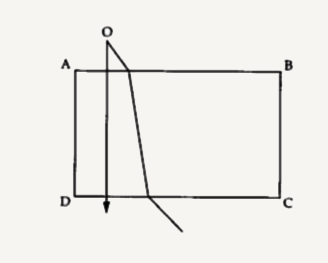A monochromatic point source of light O is seen through a rectangular glass block ABCD.
Paths of two rays, in and outside the block, are shown in the figure below.

How does the shift depend on the thickness (AD or BC) of the block?
The shift is directly proportional to the thickness of glass slab.
Topper's Solved these Questions
Similar Questions
A monochromatic point source of light O is seen through a rectangular glass block ABCD.
Paths of two rays, in and outside the block, are shown in the figure below.

Does the source at point O appear to be nearer or farther with respect to the surface AB?
View SolutionA monochromatic point source of light O is seen through a rectangular glass block ABCD.
Paths of two rays, in and outside the block, are shown in the figure below.

For the same rectangular glass block, which colour from the visible spectra will produce the maximum shift?
View SolutionA monochromatic point source of light O is seen through a rectangular glass block ABCD.
Paths of two rays, in and outside the block, are shown in the figure below.

Justify your answer with the help of an appropriate ray diagram as shown in figure.
View SolutionA point source of light O of single colour is seen through a rectangular glass slab PQRS. The paths of two rays, in and outside the slab, are shown in figure.

In the diagram, label the position I of the source O where it will appear when seen through the surface RS.
(ii) Does the source O appear to be nearer or farther with respect to the surface PQ ?
(iii) How does the shift depend on the thickness PS or QR of the slab?
(iv) Justify your answer in (iii) with the help of an appropriate ray diagram.
(v) For the same rectangular glass slab, which colour from the visible spectra (violet to red) will produce the maximum shift ?
View SolutionIn the diagram below, PQ is a ray of light incident on a rectangular glass block.

How are the angles i and 'e' related to each other?
View SolutionThe path of a ray light coming from air passing through a rectangular glass slab traced by four students are shown as A, B, C and D in Figure. Which one of them is correct ?

View SolutionIn Figure, a monochromatic point source of light S is viewed by an observer O through a prism P. complete the diagram to show the image formed by the prism and as seen by the observer O. label the image by the letter I.

View SolutionA vessel ABCD of 10cm width has two small slits S1 and S2 sealed with idebtical glass plates of equal thickness. The distance between the slits is 0.8mm. POQ is the line perpendicular to the plane AB and passing through O, the middle point of S1 and S2. A monochromatic light source is kept at S,40cm below P and 2m from the vessel, to illuminate the slits as shown in the figure. Calculate the position of the central bright fringe on the other wall CD with respect of the line OQ. Now, a liquid is poured into the vessel and filled up to OQ. The central bright fringe is fiund to be at Q. Calculate the refractive index of the liquid.

View SolutionA lever PQ, hinged at P, of mass 'm' and length 'l' lies on the drum ( solid cylinder ) of mass 'm' and radius 'R'.The drum can rotate about the horizontal axis passing through O. The coefficient of friction between the lever and drum is 1/4. A block of mass 'm' is connected through the string with the drum as shown in the figure. The string does not slip on the drum. Then the acceleration of the block is

View SolutionThe diagram alongside shows a light source P embedded in a rectangular glass block ABCD of critical angle 42∘. Complete the path of the ray PQ till it emerges out of the block. [Write necessary angles.]

View Solution
